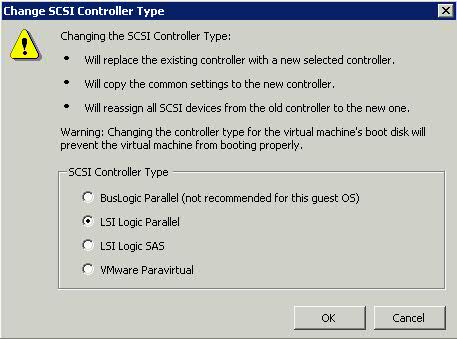VMware highly recommends using multiple virtual SCSI controllers for the database virtual machines or virtual machines with high I/O load. The use of multiple virtual SCSI controllers allows the execution of several parallel I/O operations inside the guest operating systemVMware also highly recommends separating the Redo/Log I/O traffic from the data file I/O traffic through separate virtual SCSI controllers. As a best practice, you can use one controller for the operating system and swap, another controller for DB Log, and one or more additional controllers for database data files (depending on the number and size of the Database files)
Limits
- 4 x SCSI Controllers
- 15 Disks per SCSI Controller
SCSI Controllers
BusLogic Parallel
- Older guest operating systems default to the BusLogic adapter.
- Considered Legacy
LSI Logic Parallel
- The LSI Logic Parallel adapter and the LSI Logic SAS adapter offer equivalent performance. Some guest operating system vendors are phasing our support for Parallel SCSI in favor of SAS, so if your virtual machine and guest operating system support SAS, choose LSI SAS to maintain future compatibility
LSI Logic SAS
- LSI Logic SAS is available only for virtual machines with hardware version 7
VMware Paravirtual
- Paravirtual SCSI (PVSCSI) controllers are high performance storage controllers that can result in greater throughput and lower CPU use. PVSCSI controllers are best suited for high-performance storage environments.
- PVSCSI controllers are available for virtual machines running hardware version 7 and later.
- PVSCSI only supports the following guest OS’s – Windows 2003, Windows 2008 and Red Hat Enterprise Linux 5.
- Hot add or remove requires a bus rescan from within the guest operating system.
- Disks on PVSCSI controllers might not experience performance gains if they have snapshots or if memory on the ESXi host is over committed
- SCS clusters are not supported.
- PVSCSI controllers do not support boot disks, the disk that contains the system software, on Red Hat Linux 5 virtual machines. Attach the boot disk to the virtual machine by using any of the other supported controller typeS
Do I choose the PVSCSI or LSI Logic virtual adapter on ESX 4.0 for non-IO intensive workloads?
VMware evaluated the performance of PVSCSI and LSI Logic to provide a guideline to customers on choosing the right adapter for different workloads. The experiment results show that PVSCSI greatly improves the CPU efficiency and provides better throughput for heavy I/O workloads. For certain workloads, however, the ESX 4.0 implementation of PVSCSI may have a higher latency than LSI Logic if the workload drives low I/O rates or issues few outstanding I/Os. This is due to the way the PVSCSI driver handles interrupt coalescing.One technique for storage driver efficiency improvements is interrupt coalescing. Coalescing can be thought of as buffering: multiple events are queued for simultaneous processing. For coalescing to improve efficiency, interrupts must stream in fast enough to create large batch requests. Otherwise, the timeout window will pass with no additional interrupts arriving. This means the single interrupt is handled as normal but after an unnecessary delay.The behavior of two key storage counters affects the way the PVSCSI and LSI Logic adapters handle interrupt coalescing:
- Outstanding I/Os (OIOs): Represents the virtual machine’s demand for I/O.
- I/Os per second (IOPS): Represents the storage system’s supply of I/O.
The LSI Logic driver increases coalescing as OIOs and IOPS increase. No coalescing is used with few OIOs or low throughput. This produces efficient I/O at large throughput and low-latency I/O when throughput is small.
In ESX 4.0, the PVSCSI driver coalesces based on OIOs only, and not throughput. This means that when the virtual machine is requesting a lot of I/O but the storage is not delivering, the PVSCSI driver is coalescing interrupts. But without the storage supplying a steady stream of I/Os, there are no interrupts to coalesce. The result is a slightly increased latency with little or no efficiency gain for PVSCSI in low throughput environments.
The CPU utilization difference between LSI and PVSCSI at hundreds of IOPS is insignificant. But at larger numbers of IOPS, PVSCSI can save a lot of CPU cycles
The test results show that PVSCSI is better than LSI Logic, except under one condition–the virtual machine is performing less than 2,000 IOPS and issuing greater than 4 outstanding I/Os. This issue is fixed in vSphere 4.1, so that the PVSCSI virtual adapter can be used with good performance, even under this condition.
Changing queue depths
http://pubs.vmware.com/vsphere-50
http://pubs.vmware.com/vsphere-50
Useful Article by Scott Lowe



